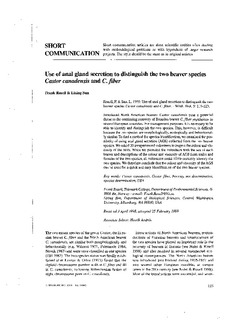| dc.contributor.author | Rosell, Frank | |
| dc.contributor.author | Sun, Lixing | |
| dc.date.accessioned | 2007-03-06T09:51:42Z | |
| dc.date.accessioned | 2017-04-19T12:25:18Z | |
| dc.date.available | 2007-03-06T09:51:42Z | |
| dc.date.available | 2017-04-19T12:25:18Z | |
| dc.date.issued | 1999 | |
| dc.identifier.citation | Wildlife biology 5(1999), No. 2, p. 119-123 | |
| dc.identifier.issn | 0909-6396 | |
| dc.identifier.uri | http://hdl.handle.net/11250/2438068 | |
| dc.description.abstract | Introduced North American beavers Castor canadensis pose a potential threat to the continuing recovery of Eurasian beaver C. fiber populations in several European countries. For management purposes, it is necessary to be able to identify and distinguish the two species. This, however, is difficult because the two species are morphologically, ecologically and behaviourally similar. To find a method for species identification, we examined the possibility of using anal gland secretion (AGS) collected from the two beaver species. We asked 20 inexperienced volunteers to inspect the colour and viscosity of the AGS. When we provided the volunteers with the sex of each beaver and descriptions of the colour and viscosity of AGS from males and females of the two species, all volunteers could 100% correctly identify the two species. We therefore conclude that the colour and viscosity of the AGS can be used for a quick and easy identification of the two beaver species. | |
| dc.format.extent | 285095 bytes | |
| dc.format.mimetype | application/pdf | |
| dc.language.iso | eng | |
| dc.publisher | Nordic Council for Wildlife Research | |
| dc.subject | Beavers | |
| dc.subject | Sex determination | |
| dc.subject | Species determination | |
| dc.subject | Anal gland secretion | |
| dc.title | Use of anal gland secretion to distinguish the two beaver species Castor canadensis and C. fiber | |
| dc.type | Journal article | |
| dc.type | Peer reviewed | |
| dc.subject.nsi | 485 | |
